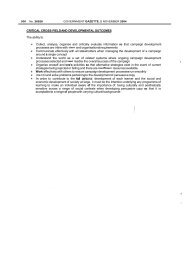Operational plan for comprehensive HIV and AIDS care and ...
Operational plan for comprehensive HIV and AIDS care and ...
Operational plan for comprehensive HIV and AIDS care and ...
Create successful ePaper yourself
Turn your PDF publications into a flip-book with our unique Google optimized e-Paper software.
DRAFT - Confidential<br />
effectiveness) of these services if necessary. These activities will require coordination<br />
with various sections of the DoH, community leaders <strong>and</strong> NGOs.<br />
The strengthening <strong>plan</strong> <strong>and</strong> subsequent deployment of appropriate resources are intended<br />
to enable a service point to meet the accreditation requirements summarised below <strong>and</strong><br />
described in greater detail in Annex IV.2. The strengthening <strong>plan</strong> will provide detailed<br />
strategies to meet the requirements. The <strong>plan</strong> will encourage maximum integration with,<br />
<strong>and</strong> improvement of, existing health<strong>care</strong> resources. In addition, a service point should<br />
have flexibility to tailor the way it proposes to meet a specific requirement in a manner<br />
that reflects the service point’s needs <strong>and</strong> characteristics.<br />
Accreditation Requirements<br />
The following criteria summarise the conditions necessary at a service point to ensure high<br />
quality <strong>comprehensive</strong> <strong>HIV</strong> <strong>and</strong> <strong>AIDS</strong> <strong>care</strong> <strong>and</strong> treatment.<br />
1. Presence of a service point project manager, who will supervise programme conduct<br />
<strong>and</strong> expansion. Where practical <strong>and</strong> effective, a project manager may supervise<br />
programme conduct <strong>and</strong> expansion <strong>for</strong> more than one service point.<br />
2. Availability of a trained <strong>care</strong> team on-site with representation of all relevant<br />
professions (clinicians, nurses, <strong>and</strong> counsellors), easy access to trained laboratory,<br />
pharmacy <strong>and</strong> nutritional staff, <strong>and</strong> links to NGOs <strong>and</strong> other service providers. The<br />
<strong>care</strong> team should consist of sufficient staff in appropriate ratios to manage the<br />
projected number of patients.<br />
3. Implementation <strong>and</strong> maintenance of current st<strong>and</strong>ards of <strong>care</strong> as provided by the<br />
National Treatment Policy Guidelines.<br />
4. Access to <strong>care</strong> 24-hours a day at the service point, or in the direct vicinity, with<br />
coverage relationships explicit to both facility staff <strong>and</strong> patients.<br />
5. A staff recruitment, training <strong>and</strong> skills development <strong>plan</strong> in place <strong>for</strong> health <strong>care</strong><br />
workers responsible <strong>for</strong> <strong>HIV</strong> <strong>and</strong> <strong>AIDS</strong> <strong>care</strong> <strong>and</strong> treatment (including volunteers <strong>and</strong><br />
lay counsellors) based on initial needs <strong>and</strong> projected long-term patient numbers.<br />
6. Appropriate numbers of consultation, treatment <strong>and</strong> counselling rooms should be<br />
available to assure patient confidentiality, based on projected patient numbers.<br />
Chapter IV: Accreditation of Service Points 98
















